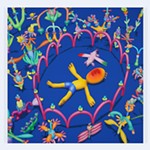Accidental Death of an Anarchist
Staging of Fo's farce never quite musters the urgent lunacy of its Looney Tunes inspiration
Reviewed by Robert Faires, Fri., Sept. 21, 2007
Accidental Death of an Anarchist
The Vortex, through Sept. 30
Running time: 2 hr, 25 min
Bugs Bunny. Now, there was a man, um, hare, who really knew how to subvert the status quo, to pull the rug out from under the establishment, to get anyone in a position of power – be he mobster, hunter, or Tasmanian Devil – dancing to his tune without the poor sap even realizing it. Don't be surprised to find yourself weflecting on the wascally wabbit as you wait for the start of the Vortex Repertory Company-Renaissance Austin Theatre co-production of Accidental Death of an Anarchist. The preshow music spilling from the speakers is drawn from vintage Warner Bros. cartoons, and those scores are so distinctive and so memorable that, even without the images they accompanied, they readily summon up the animated jokers and buffoons featured in them.
And that actually serves as a useful aural cue for this 1970 political farce. Playwright Dario Fo draws on the stock characters of commedia for his over-the-top cops and the subversive Madman who gets the best of them, but American audiences who don't know their lazzi from a hole in the ground are much more likely to be familiar with these staples of broad comedy from their latter-day counterparts in comic strips and cartoons. The Madman, as he's dubbed in this translation by Ron Jenkins and Gloria Pasterino, is very much a wise guy in the tradition of Bugs, a trickster figure who lives by his wits and typically uses them to turn the tables on the authorities, playing them for fools. Which he does to a crew of corrupt cops who claim that a suspect they were questioning about a bombing jumped out of a fourth-floor window and killed himself. Passing himself off as a judge, the Madman slyly manipulates the policemen into reenacting their interrogation and eventually admitting that the anarchist was pushed.
You can see director Lorella Loftus and company doing their best to channel the lunacy of Looney Tunes and its street-theatre forebears: the elaborate make-up with exaggerated features that falls somewhere between commedia masks and cartoon faces; the silly walks and impulsive jigs; the pop eyes, crossed eyes, and other broad reactions. Like an animated prankster, Robert Deike's Madman whips into and out of assorted personae, brandishing a different oddball voice or whacked accent for each: a German shrink; a legal scholar from the Deep South; a cranky, ancient magistrate; a rabid dog. He's more than a match for the clueless cops, as Gabriel Maldonado and Chronicle Arts writer Hannah Kenah dial down the intellects of their commissioner and inspector, respectively, to subbasement levels. Kenah's bantam rooster cop, sporting Seventies threads and Serpico 'stache and rabbit-punching the air whenever he's agitated, and Maldonado's priss of a commish, his fingertips daintily touching in front of his chest and his face like a surprised guppy, are cartoony enough to have stepped down off Chuck Jones' drawing board.
The thing about those cartoons, however – and the commedia that preceded them – is that they thrive on quickness and spontaneity, a manic pace that helps keep the object of the protagonist's manipulations off guard and feeds our sense that the wily hero is constantly thinking on his feet, improvising, the tricks and gags erupting extemporaneously from his irrepressible imagination. Much of what happens in this staging of Fo's farce, though, feels rehearsed. The pace and not a few of the comic bits come off as deliberate; we can see the thought behind the action, which lets the air out of the comedy. Some of that may be a lack of polish in the routines or lack of experience by certain players. (If comedy is hard, the clowning demanded by a comedy like Fo's is harder still.) Some of it may have been the smallish, relatively quiet house on the Sunday night I saw the show. Whatever the culprit, the show didn't flash with the madcap urgency of its inspiration.
Thirty-seven years after the fact, Fo still has much to say to us about abusive authority figures and the way to truth through mocking them, and much of that can be gleaned from this production. But you may leave the theatre wanting that gleeful insanity that goes with the cartoon music in your head.











